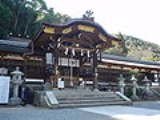
Matsunoo Shrine
Encyclopedia
is a Shinto shrine located at the far western end of Shijo Street
, approximately 1.3 kilometers south of the Arashiyama
district of Kyoto
, Japan
. It is home to a spring
at the base of the mountain, Arashiyama, that is believed to be blessed.
It is said that during the move of the capital from Nagaoka
to Kyoto, a noble saw a turtle bathing in under the spring's waterfall and created a shrine there. It is one of the oldest shrines in the Kyoto area, its founding extending back to 700 AD. The restorative properties of the spring bring many local sake and miso
companies to the shrine for prayers that their product will be blessed.
The shrine also serves a kinpaku (gold leaf filled) miki (or blessed sake) during hatsumode
.
. In 965, Emperor Murakami
ordered that Imperial messengers were sent to report important events to the guardian kami of Japan. These heihaku were initially presented to 16 shrines including the Matsunoo Shrine.
From 1871 through 1946, Matsunoo-taisha was officially designated one of the , meaning that it stood in the first rank of government supported shrines.
Shijo Street
runs center of Kyoto, Japan east to west through the commercial center of the city. Shijō literally means fourth street of Heian-kyō, the ancient capital.- Along the street :...
, approximately 1.3 kilometers south of the Arashiyama
Arashiyama
is a district on the western outskirts of Kyoto, Japan. It also refers to the mountain across the Ōi River, which forms a backdrop to the district.Notable tourist sites in Arashiyama include...
district of Kyoto
Kyoto
is a city in the central part of the island of Honshū, Japan. It has a population close to 1.5 million. Formerly the imperial capital of Japan, it is now the capital of Kyoto Prefecture, as well as a major part of the Osaka-Kobe-Kyoto metropolitan area.-History:...
, Japan
Japan
Japan is an island nation in East Asia. Located in the Pacific Ocean, it lies to the east of the Sea of Japan, China, North Korea, South Korea and Russia, stretching from the Sea of Okhotsk in the north to the East China Sea and Taiwan in the south...
. It is home to a spring
Spring (hydrosphere)
A spring—also known as a rising or resurgence—is a component of the hydrosphere. Specifically, it is any natural situation where water flows to the surface of the earth from underground...
at the base of the mountain, Arashiyama, that is believed to be blessed.
It is said that during the move of the capital from Nagaoka
Nagaokakyo, Kyoto
is a city located in Kyoto, Japan.As of 2008, the city has an estimated population of 79,306 and the density of 4,070.96 persons per km². The total area is 19.18 km²....
to Kyoto, a noble saw a turtle bathing in under the spring's waterfall and created a shrine there. It is one of the oldest shrines in the Kyoto area, its founding extending back to 700 AD. The restorative properties of the spring bring many local sake and miso
Miso
is a traditional Japanese seasoning produced by fermenting rice, barley and/or soybeans, with salt and the fungus , the most typical miso being made with soy. The result is a thick paste used for sauces and spreads, pickling vegetables or meats, and mixing with dashi soup stock to serve as miso...
companies to the shrine for prayers that their product will be blessed.
The shrine also serves a kinpaku (gold leaf filled) miki (or blessed sake) during hatsumode
Hatsumode
is the first shrine visit of the New Year in Japan. Some people visit a Buddhist temple instead. Many visit on the first, second, or third day of the year as most are off work on those days. Generally, wishes for the new year are made, new o-mamori are bought, and the old ones are returned to the...
.
History
The shrine became the object of Imperial patronage during the early Heian periodHeian period
The is the last division of classical Japanese history, running from 794 to 1185. The period is named after the capital city of Heian-kyō, or modern Kyōto. It is the period in Japanese history when Buddhism, Taoism and other Chinese influences were at their height...
. In 965, Emperor Murakami
Emperor Murakami
was the 62nd emperor of Japan, according to the traditional order of succession.Murakami's reign spanned the years from 946 to his death in 967.-Traditional narrative:...
ordered that Imperial messengers were sent to report important events to the guardian kami of Japan. These heihaku were initially presented to 16 shrines including the Matsunoo Shrine.
From 1871 through 1946, Matsunoo-taisha was officially designated one of the , meaning that it stood in the first rank of government supported shrines.
See also
- List of Shinto shrines
- Twenty-Two Shrines
- Modern system of ranked Shinto ShrinesModern system of ranked Shinto ShrinesThe The The (sometimes called simply , was an organizational aspect of the establishment of Japanese State Shinto. This system classified Shinto shrines as either official government shrines or "other" shrines...
External links
- Official Site (English)
- Official Site (Japanese)

